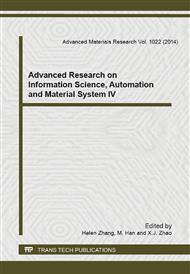[1]
J. Diaz, D. Arroyo, F. B. Rodriguez: A formal methodology for integral security design and verification of network protocols, Journal of Systems and Software, Vol. 89 (2014), pp.87-98.
DOI: 10.1016/j.jss.2013.09.020
Google Scholar
[2]
M. S. B. Mahmoud, A. Pirovano, N. Larrieu: Aeronautical communication transition from analog to digital data: A network security survey, Computer Science Review, Vol. s11–12 (2014), pp.1-29.
DOI: 10.1016/j.cosrev.2014.02.001
Google Scholar
[3]
H. Mouratidis, P. Giorgini, G. Manson: When security meets software engineering: a case of modelling secure information systems, Information Systems, Vol. 30 (2005), pp.609-629.
DOI: 10.1016/j.is.2004.06.002
Google Scholar
[4]
R. Jamieson, G. Low: Security and control issues in local area network design, Computers & Security, Vol. 8 (1989), pp.283-290.
DOI: 10.1016/0167-4048(89)90087-4
Google Scholar
[5]
S. Gritzalis, D. Spinellis, P. Georgiadis: Security protocols over open networks and distributed systems: formal methods for their analysis, design, and verification, Computer Communications, Vol. 22 (1999), pp.697-709.
DOI: 10.1016/s0140-3664(99)00030-4
Google Scholar
[6]
C. Gutiérrez, D. G. Rosado, E. F. Medina: The practical application of a process for eliciting and designing security in web service systems, Information and Software Technology, Vol. 51 (2009), pp.1712-1738.
DOI: 10.1016/j.infsof.2009.05.004
Google Scholar
[7]
C. Guariniello, D. DeLaurentis: Communications, Information, and Cyber Security in Systems-of-Systems: Assessing the Impact of Attacks through Interdependency Analysis, Procedia Computer Science, Vol. 28 (2014), pp.720-727.
DOI: 10.1016/j.procs.2014.03.086
Google Scholar
[8]
M. A. Aydın, A. H. Zaim, K. G. Ceylan: A hybrid intrusion detection system design for computer network security, Computers & Electrical Engineering, Vol. 35 (2009), pp.517-526.
DOI: 10.1016/j.compeleceng.2008.12.005
Google Scholar
[9]
S. Atay, M. Masera: Challenges for the security analysis of Next Generation Networks, Information Security Technical Report, Vol. 16 (2011), pp.3-11.
DOI: 10.1016/j.istr.2010.10.010
Google Scholar
[10]
L. Hong, W. Chen: Information theory and cryptography based secured communication scheme for cooperative MIMO communication in wireless sensor networks, Ad Hoc Networks, Vol. 14 (2014), pp.95-105.
DOI: 10.1016/j.adhoc.2013.11.008
Google Scholar
[11]
M. Leitner, S. Rinderle: A systematic review on security in Process-Aware Information Systems -Constitution, challenges, and future directions, Information and Software Technology, Vol. 56 (2014), pp.273-293.
DOI: 10.1016/j.infsof.2013.12.004
Google Scholar
[12]
D. Jurcut, T. Coffey, and R. Dojen: Design guidelines for security protocols to prevent replay & parallel session attacks, Computers & Security, Vol. 45 (2014), pp.255-273.
DOI: 10.1016/j.cose.2014.05.010
Google Scholar
[13]
J. S. Baras: Security and Trust for Wireless Autonomic Networks Systems and Control Methods, European Journal of Control, Vol. 13 (2007), pp.105-133.
DOI: 10.3166/ejc.13.105-133
Google Scholar


